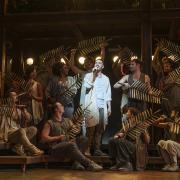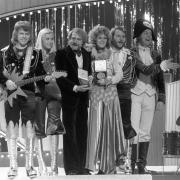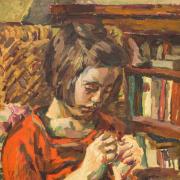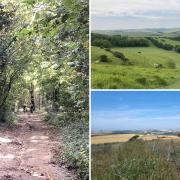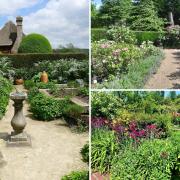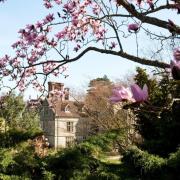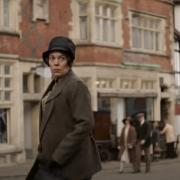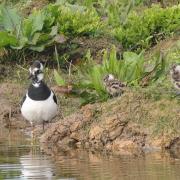Solution for the ‘… his books were read’ piece by Tony Ward in the Sussex Life March issue
Who is it? ‘… his books were read’
A complex man, a diverse life,
anarchic, eccentric,
turbulent, dissident,
his cornerstone, his rock, his faith.
.
French father, English mother,
born in France but Sussex bred.
Slindon, Salford, Shipley,
elected, returned, rejected.
.
Back to the South Country,
the Sussex which is Eden still,
walking the Downs,
sailing her sea,
The passer-by shall hear me still,
A boy that sings on Duncton Hill.
.
Writer, orator, historian, poet,
Sussex patriot, soldier’s friend.
Verses and Sonnets, people and places,
the bad child’s beasts, the Cautionary Tales.
armies of words, a sense of fun,
Matilda, Jim and Henry King.
.
But public mirth masked private grief,
death of his sons, death of his wife.
Despair, dark days,
but winning through,
by laughter and the love of friends.
.
A tower and spire now marks his grave,
His legacy his works …
.
When I am dead, I hope it may be said:
His sins were scarlet, but his books were read.
Solution – Hilaire Belloc (1870 – 1953) – Poet, prolific writer and, briefly, an MP.
Explanation of embedded clues
Joseph Hilaire Pierre René Belloc, to give him his full name, was born in La Celle-Saint-Cloud, a village near Paris, to a French father and an English mother
Hilaire Belloc is best known for his incomparable humorous verses for children, perhaps the most popular volume being Cautionary Tales for Children (1907), a potent mixture of pleasure and terror. Parents also loved them, and still do. Like a lot of modern young children’s picture books they appeal to the Mum or Dad reading them aloud as well as to the child. The humour (and the moralistic messages) are on two levels.
However, Belloc was far more than just a writer of ‘comic verses for kids’. He was “A complex man, (with) a diverse life / anarchic, eccentric, / turbulent, dissident”. He was in turn, and in parallel, a “Writer, orator, historian, poet, / Sussex patriot, soldier’s friend”. He was also a Member of Parliament (1906-1910), a long-distance walker, a keen sailor, a satirist, a soldier, a political activist, a lay champion of the Roman Catholic church (“his cornerstone, his rock, his faith”) and a campaigner for the preservation of rural England. He had a deep-rooted distrust of modern industrial society. In tune with the conservationists of the 1920s he sprang to the defence of the County after ‘London broke out like a bursting reservoir’. He asked ‘Can Sussex endure?’. He put these fears into verse memorably in his poem Ha’nacker Mill. This tower windmill, near Boxgrove, was built in 1750 for Goodwood Estates, but during Belloc’s lifetime it became derelict.
Ha’nacker’s down and England’s done,
And never a ploughman under the Sun,
Never a ploughman. Never a one.
Belloc though had a wider political agenda. He was a critic both of capitalism and of many aspects of socialism. With his close friend G. K. Chesterton, among others, he advocated ‘Distributism’. Essentially this advocated a return to the economic system prevalent in Europe for the thousand years when it was Catholic, a post-industrial society recalling the principle of ‘three acres and a cow’ as the basic farming unit. He expounded his philosophy fully in one of his best-known non-fiction books The Servile State (1912).
Hilaire Belloc’s mother brought her two-year-old son and her daughter, Marie, back to England following the death of his father. Initially the family settled in London, but in 1878, when Hilaire was eight years of age, they moved to Sussex. Belloc spent his boyhood in the County, “Sussex bred”, and returned there at the age of thirty-three - “Back to the South Country, / the Sussex which is Eden still”. He had no wish to move away again and spent the last fifty years of his life singing the praises of his adopted home. He has been called the ‘Sussex patriot’ and ‘The Sussex Poet Laureate’. The South Country is the title of perhaps the best known of his ‘Sussex’ poems. It is partly autobiographical and is a deeply moving expression of his love for Sussex.
“Slindon, Salford, Shipley”. Slindon and Shipley refer firstly to the home to which Belloc’s widowed mother brought her young family and then to the place to which Belloc returned and where he made a home for his own wife, Elodie, and their five young children. At the time that they moved to their final home, King’s Land, in 1906, the oldest child, Louis John, was nine years old and the youngest, Peter, just two. For £900 Belloc purchased the house, five acres of land and Shipley Windmill. After their cramped Chelsea home, followed by an interim period at Bleak House, Slindon, at last the family had room to breathe.
But “Salford”? Belloc had graduated from Balliol College, Oxford in !895 with a first class honours degree in History. He had also been President of the Oxford Union Debating Society and was a formidable debater, nicknamed ‘Old Thunder’. Later in his career, H. G. Wells remarked that ‘Debating Mr. Belloc is like arguing with a hailstorm’. It was perhaps only natural that he should go into politics. First though, there was another matter to attend to. The year after graduation, after a wait of six years, he married Elodie, the daughter of Irish-American emigrants, in California. In 1902 he became a naturalised British subject (1902). The way was then clear to enter Parliament.
From 1906 to 1910, Hilaire Belloc was the Member of Parliament for Salford South. The line “elected, returned, rejected” describes this period. In the 1906 General Election Belloc was elected as the Liberal MP for South Salford. His nature however had always been “turbulent, dissident” and it wasn’t long before he fell out with the Prime Minister, Sir Henry Campbell-Bannerman. He felt that his government was not radical enough. In the January 1910 General Election Belloc therefore he stood for election as an Independent candidate. He won a narrow victory, but in a second ‘re-run’ General Election in December of that year he lost his seat.
Now full-time back in Sussex he enjoyed “walking the Downs, sailing her sea”. Regarding the first of these Peter Brandon suggests that Belloc should be nominated ‘The Prince of Sussex Walkers’. He was always to be found ‘walking in the high woods … smell(ing) the Sussex air … (and) Within a walk of the sea’. He thought that the view of the Downs near Arundel was perhaps the ‘most verse producing mile in the world’. Belloc didn’t restrict himself to short walks around his home though, he undertook a pioneering walk along what was to become the South Downs Way. In his book The Four Men, four imaginary characters, each a reflection of aspects of his own character set out on a walking tour across Sussex, starting from The George at Robertsbridge and proceeding across the County to South Harting.
Belloc didn’t only walk in Sussex. When courting his future wife Elodie in 1891, as an impecunious 21-year-old, he is said to have crossed the United States from Atlantic to Pacific part-walking and part by train to reach her parents’ home in northern California. He “paid” for his overnight stays at people’s homes along the way by sketching the owners and reciting poetry. Another of Belloc’s long-distance walks is recorded in his book The Path to Rome (1902), his pilgrimage from central France across the Alps and down to Rome.
His other love was sailing. As usual he liked to excel. As a yachtsman he won many races and was on the French sailing team. He bought his first ‘longer-distance’ sailing boat in 1901, which he moored firstly at Littlehampton. This was the cutter Nona. Soon after he bought her he gives a breath-taking account of a storm at sea, ‘… off Beachy Head by Birling Gap on Whit Tuesday 1902, a day ever to be remembered … the air fell off Birling Gap just like water out of a bucket, and nearly blew the Nona flat upon her beam … (it continues)’. In his sea classic, Cruise of the Nona (1925) he gives a vivid account of his voyage down the Irish Sea and up the English Channel to his (then) home port of Shoreham.
Hilaire Belloc published around 150 books together with a vast quantity of letters and articles for magazines, newspapers and journals. He was one of the ‘Big Four of Edwardian Letters’. The others were H. G. Wells, George Bernard Shaw and G. K. Chesterton. The latter was a co-editor with Belloc of a literary periodical and also a writing partner. G. B. Shaw referred to the pair as Chesterbelloc.
The phrase “soldier’s friend’ in the poem refers to his editorship of Land and Water during the First World War. This was part of his support for the war effort for the War Propaganda Bureau. He ‘told it as it was’ as regards the lives (and deaths) of the ordinary soldiers. He had credibility having himself served a term of voluntary French military service before taking up his place at Oxford University. He was however always careful to maintain morale and confided to his friend, Chesterton, that ‘it is sometimes necessary to lie damnably in the interests of the nation’.
The breadth of his writing is touched upon in verse four of the poem - Poetry for adults, poetry for children, song lyrics, novels, essays, political and religious tracts, satire, history books, biographies and travelogues. The subjects covered included politics, economics, history, warfare, religion, countryside conservation, walking, sailing, and of course several works on his beloved county of Sussex. He wrote more about Sussex than has any other significant writer.
“The bad child’s beasts” in verse four refer to his first two books of humorous, but somewhat nightmare-inducing, verses for children. The Bad Child’s Book of Beasts was published in 1896, and More Beasts for Worse Children the following year. As a new Dad he must have been looking well ahead. Hilaire and Elodie’s first child was born in the same year as the second volume was published. In 1907, when Louis John was ten, out came Cautionary Tales for Children. “Matilda, Jim and Henry King” were some of the unfortunate children who featured in the poems. All three poems are subtitled with gruesome warnings. Matilda – ‘Who told lies, and was burned to death’, Jim – ‘Who ran away from his nurse, and was eaten by a lion’, and Henry King – ‘Who chewed bits of string, and was early cut off in dreadful agonies’. Such was the popularity of the latter that in 1930, long after his own children had grown up, he produced a further volume, New Cautionary Tales.
Sadly, his two sons didn’t survive to read the Tales to their own children. “But public mirth masked private grief, / death of his sons, death of his wife”. Elodie died in 1914 at the age of 45. They had been married for just 18 years. Belloc was shattered – “Despair, dark days”. For the remaining 39 years of his life he wore mourning, but he didn’t shut himself away. “Laughter and the love of friends” pulled him through. Sometimes in his verses though you can sense his grief:
But when I slept I saw your eyes,
Hungry as death, and very far.
In his Introduction to the anthology Complete Verse: Hilaire Belloc, A.N. Wilson writes ‘That is a poem which, for me, passes A. E. Houseman’s gooseflesh test’.
As regards his two sons. John Louis, the eldest was killed on active service with the Royal Flying Corps in August 1918, towards the end of World War I, and his second son, Peter was killed in 1941 when serving with the Royal Marines in World War II. Not long after Peter’s death, Belloc suffered a stroke. He became an invalid. The brain damage caused by the stroke had also resulted in symptoms similar to dementia. His writing and travelling had come to an end.
Hilaire’s body joined Elodie’s in 1953 in the family grave in their regular Church, the Catholic Shrine Church of Our Lady of Consolation and St Francis in West Grinstead. A plaque also records the fact that the shrine’s tower, completed in 1964, was built in his memory – “A tower and spire now marks his grave”. As the last two lines of the poem make clear “His legacy (were) his works”, or as Belloc put it:
When I am dead, I hope it may be said:
His sins were scarlet, but his books were read.
Finally, as we walk his Downs, a couplet from a poem which could be interpreted as his own ‘Sussex’ epitaph, comes to mind:
The passer-by shall hear me still,
A boy that sings on Duncton Hill.
Acknowledgement of sources
• Peter Brandon, The Discovery of Sussex, Phillimore, 2010 (Many page references, see Index)
• Ana Sampson, I Wandered Lonely as a Cloud …, Michael O’Mara, 2013 (pp. 121-122) (Brief interesting anecdotes plus his poem ‘Tarantella’).
• John Wain (Ed.), The Oxford Library of English Poetry, BCA/OUP, 1993 (Vol. 3, pp. 301-306)
• A.N. Wilson (Intro.), Complete Verse: Hilaire Belloc, Pimlico, 1991.
• en.wikipedia.org/wiki/Hilaire_Belloc (As well as biography this contains an extensive list of his articles, illustrating the diversity of his writing, in addition to his more than 150 books).
• en.wikiquote.org/wiki/Hilaire_Belloc (A selection of quotes from Hilaire Belloc’s writings).
• spartacus-educational.com/PR belloc.htm (A concise biography by John Simkin covering the main events in Belloc’s life with some illuminating asides).
• www.poetryarchive.org/poet/hilaire-belloc (A single-page summary biography)
• www.sussexlife.co.uk/people/the_sussex_poet_laureate_hilaire_belloc_remembered_1_2231378 (An article by Roberta Grieve focussing in particular on Belloc’s Sussex connection).
• www.consolation.org.uk/belloc.html (From the website of the Church where Hilaire Belloc is buried, and where as a parishioner he regularly attended Mass. A biography including extracts from ‘Sussex’ poems together with a chronological list of Highlights of Belloc’s Life).
• www.findagrave.com/cgi-bin/fg.cgi?page=gr?GRid=6884181 (includes photos of Belloc’s plaque and family grave).
• Relevant websites found by searches for ‘Hilaire Belloc’, ‘Hilaire Belloc and Sussex’, Hilaire Belloc quotes’, ‘Hilaire Belloc’s gravestone’, ‘Elodie Belloc’.
Tony Ward’s book, Unravelling Sussex, contains all his Sussex Life puzzle poems and more - it is published by The History Press, RRP £12.99.



